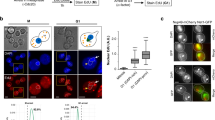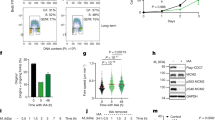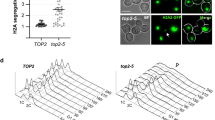Abstract
ONE of the more puzzling aspects of synchronized cell division in heat-treated Tetrahymena has been the relative asynchrony of DNA synthesis which persists following the synchronizing treatment. This phenomenon has been well documented in the past and is perhaps most simply demonstrated by the fact that only about 50 per cent of the cell nuclei label with thymidine between the end of the heat-treatment (EHT) and the first synchronous division (SD)1. Because spectrophotometric measurements of the DNA content of EHT cells have shown that they contain two to three times the DNA found in an average log cell2, the reasons for additional DNA synthesis after EHT have been even more obscure. In the past it has usually been suggested that DNA replication is complete at EHT and that this further synthesis in some cells merely represents redundant DNA accumulation by “mature” nuclei3 known to be polyploid4.
This is a preview of subscription content, access via your institution
Access options
Subscribe to this journal
Receive 51 print issues and online access
$199.00 per year
only $3.90 per issue
Buy this article
- Purchase on Springer Link
- Instant access to full article PDF
Prices may be subject to local taxes which are calculated during checkout
Similar content being viewed by others
References
Cerroni, R. E., and Zeuthen, E., C.R. Trav. Lab. Carlsberg, 32, 499 (1962).
Scherbaum, O. H., Exp. Cell Res., 13, 24 (1957).
Zeuthen, E., in Synchrony in Cell Division and Growth (edit. by Zeuthen, E.), 130 (Interscience, New York, 1964).
Nanney, D. L., Biol. Bull., 105, 133 (1953).
Lazarus, L. H., Levy, M., and Scherbaum, O. H., Exp. Cell Res., 36, 672 (1964).
Byfield, J. E., and Scherbaum, O. H., Science, 156, 1504 (1967).
Byfield, J. E., and Scherbaum, O. H., Proc. US Nat. Acad. Sci., 57, 602 (1967).
Byfield, J. E., and Scherbaum, O. H., Anal. Biochem., 17, 434 (1966).
Frankel, J., C.R. Trav. Lab. Carlsberg, 33, 1 (1962).
Author information
Authors and Affiliations
Rights and permissions
About this article
Cite this article
BYFIELD, J., SCHERBAUM, O. Incomplete Inhibition of Synchronized Cell Division by Hydroxyurea and its Relevance to the Normal Cellular Life Cycle. Nature 216, 1017–1018 (1967). https://doi.org/10.1038/2161017a0
Received:
Revised:
Published:
Issue Date:
DOI: https://doi.org/10.1038/2161017a0
This article is cited by
-
Replication and functions of macronuclear DNA in synchronously growing populations of Tetrahymena pyriformis
Carlsberg Research Communications (1977)
-
RNS- und Proteinsynthese im Ablauf der Spermatocytenteilungen von Pales ferruginea (Nematocera)
Chromosoma (1970)
Comments
By submitting a comment you agree to abide by our Terms and Community Guidelines. If you find something abusive or that does not comply with our terms or guidelines please flag it as inappropriate.



